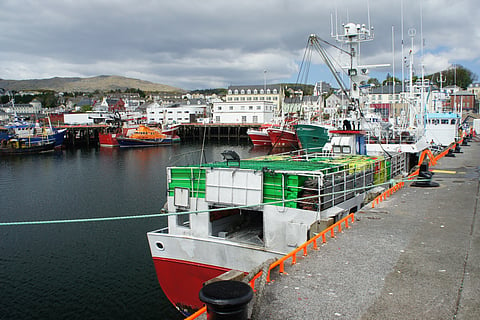

Killybegs in Donegal is one of Ireland's main seafood hubs.
Photo: Adobe Stock.
Ireland’s ten main fishing ports continue to serve as vital economic lifelines for coastal communities, supporting thousands of jobs and sustaining local businesses. However, the sector is facing ongoing challenges, including falling turnover, reduced employment, and changing market conditions, according to a new series of reports published by Bord Iascaigh Mhara (BIM), Ireland’s seafood development agency.
The series, The Economic Impact of the Seafood Sector at Ireland’s Main Ports, developed in partnership with Oxford Economics, includes one national report and ten individual port profiles. It analyses trends from 2018 to 2023 and outlines the contribution of commercial fishing, aquaculture, and seafood processing to local and national economies.
According to the reports, the seafood industry generated approximately €736 million for the Irish economy in 2023 and supported more than 8,760 jobs across the main fishing ports, including not only direct employment in fishing and seafood processing but also associated roles in transportation, services, and other local enterprises.
Perhaps unsurprisingly, in 2023 commercial fishing remained the largest direct employer within the ports, employing 1,940 people directly, and supporting a total of 2,880 jobs when related or downstream industries are included. The sector contributed €247.2 million in Gross Value Added (GVA) and €94.8 million in wages.
However, the BIM reports underscore ongoing challenges faced by Ireland's fishing sector, including reduced quotas and increasing operational costs - factors which BIM says contributed to a 23% decline in GVA and a 15% fall in employment in the fishing industry during 2018-2023. The three ports most heavily impacted by this were Union Hall in West Cork, Greencastle in County Donegal and Kilmore Quay in County Wexford, according to the BIM figures.
Meanwhile, the GVA of Ireland's aquaculture sector also saw a decline of 7.5% to €90.9 million in 2023. Aquaculture supported an estimated 1,035 jobs, and directly employed 640 people within the ports.
Aquaculture activities were found to be concentrated in a small number of ports, with Killybegs alone accounting for nearly one third, or €31.8 million, of aquaculture turnover in the country, followed by Castletownbere, County Cork, and Greencastle, County Donegal.
The reports show that despite the challenges affecting the seafood sector as a whole, seafood processing saw notable growth between 2018-2023, contributing an increasing share of employment and GVA in several ports.
Turnover grew by 7.8%, while GVA increased by over 10% to reach €438.2 million in 2023. Meanwhile, employment in the sector rose by over 19%, reaching 5,185 jobs in 2023, accompanied by a 17.5% rise in the number of processing operators.
Ports that saw the most significant expansion of the processing sector between 2018-2023 included Ros an Mhíl in County Galway and Howth in County Dublin.
"The data contained in these BIM reports, developed in partnership with Oxford Economics, clearly illustrate the leading role of Ireland’s fishing ports to local economies," said Dr Emmet Jackson, Director of Economic and Strategic Services at BIM, in a news release.
"Ireland’s main ports are important for seafood production and for sustaining jobs and communities along the coast. While the fishing sector faces ongoing pressures, Ireland’s ports have shown remarkable resilience, with seafood processing and supply chain industries playing an increasingly important role. Supporting these ports so they can continue to adapt and evolve will ensure they thrive for future generations.”
The full set of reports can be accessed via the BIM website.
